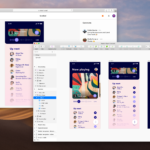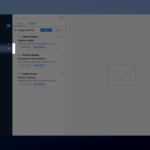Sketch, maker of popular design tools, just landed $20 million in Series A funding from Benchmark in its first outside round
You’ve probably noticed: Design has become central for many businesses that might have once considered it an afterthought. Indeed, with sales and marketing so thoroughly optimized at this point — and companies wondering how else to trounce the competition — there’s now a race afoot for numerous startups looking to become the Salesforce of design.
InVision is one of them. Just three months ago, the design collaboration startup raised $115 million in Series F funding at a $1.9 billion valuation. More recently, Figma, another design player, sealed up $40 million in Series C funding in a round that brings its total funding to $82.9 million and a valuation of $440 million.
Still, if the venture firm Benchmark has its way, Sketch — a seven-year-old, 42-person, Europe-based company — is going to win this race. Truth be told, Benchmark jumped at the chance to back Sketch founders Emanuel Sá and Pieter Omvlee when they reached out to the firm, says Chetan Puttagunta, the newest general partner at Benchmark. “We’d definitely known of Sketch and once we got a look at the company, we were blown away by it. There’s so much potential of what this could be that things moved fast. There wasn’t much of a negotiation. We were like, ‘What do you guys want to do? Let’s do it.’ ”
It helps that Sketch — which has a completely distributed workforce, with designers and other employees based around Europe and the U.S. — has been profitable from the outset, and that one million people have already paid $99 for a perpetual license (with one year of free updates).
Also impressive: those sales are entirely organic, and they are directly from Sketch’s site. Though its design tools were formerly available in the Mac App Store — Apple once gave it a design award and it routinely topped the Mac App Store charts — Sketch parted ways with the company back in 2015, including owing to Apple’s guidelines about what a Mac app can and can’t do, and the time Apple takes to approve app updates, among other things.
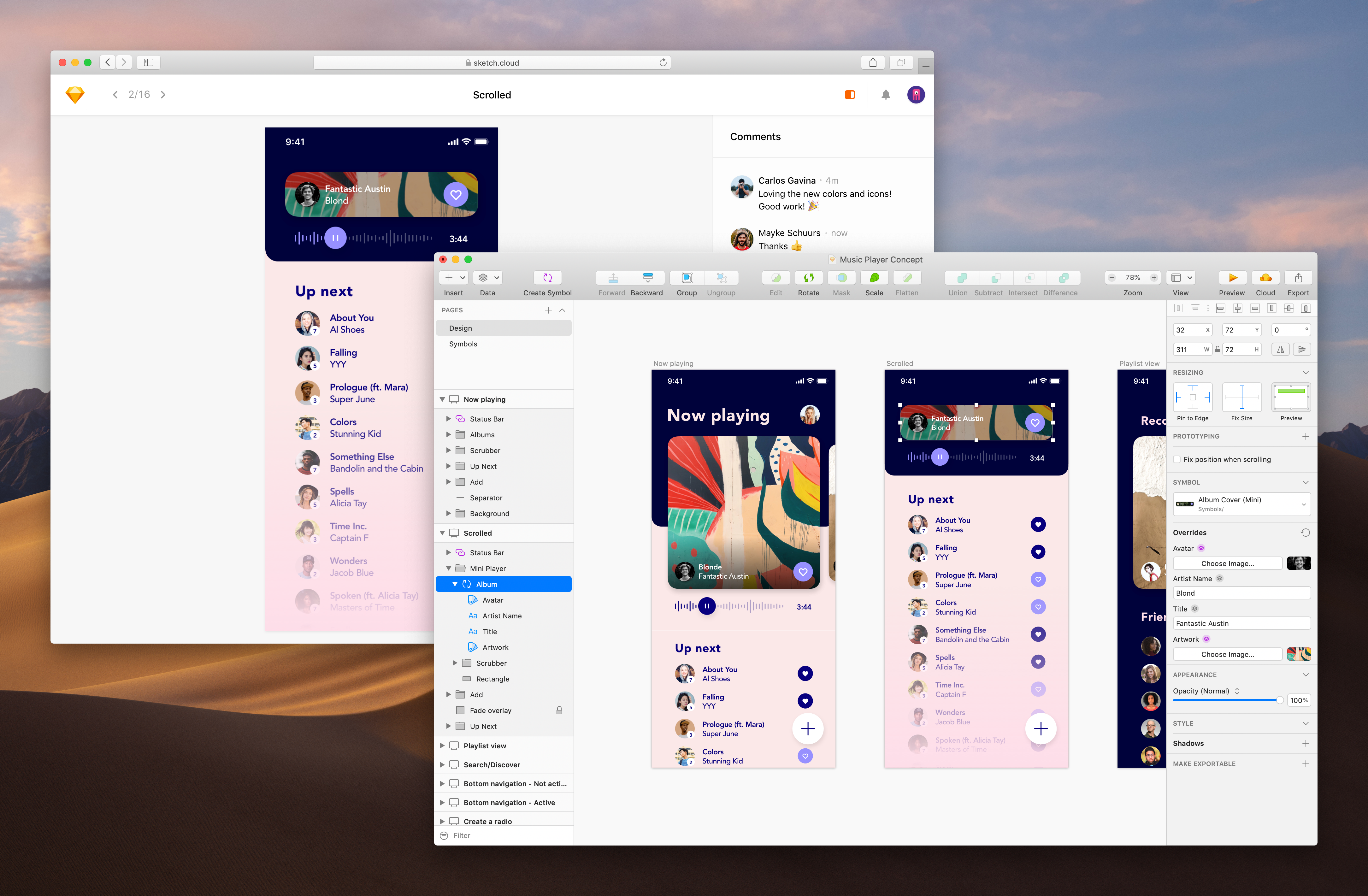
Benchmark — which isn’t sharing Sketch’s post-money valuation or how much of the company that $20 million is buying the venture firm — also sees a future wherein Sketch moves beyond its roots as a prototyping tool for both highly experienced and novice designers to build out their experience without the help of coders. The idea is for it to become a tool that teams big and small can gather around. In other words, like InVision and Figma (and Adobe and Autodesk), Sketch is going after the enterprise now, too.
In fact, Sketch is already planning some big upgrades that will be available this summer, as Sá and Omvlee told us yesterday from their respective offices in Portugal and The Netherlands. One major offering around the corner that builds on its existing cloud offering is team collaboration, via a tool called Sketch for Teams. As the two tell us, Sketch wants to be where all documents live and it will allow teams to make annotations and comments in the app.
Sketch is also bringing its tools to the browser starting later this year so users can render an entire document, add developer hand-off and allow editing along with collaboration, all without the need to leave the browser.
All of these features will be made available to anyone who downloads Sketch. In other words, then, as now, everyone gets the same functionality. Asked if there may eventually be features for enterprises that are not available to Sketch’s loyal base of current customers, Puttagunta says it’s a possibility, but that “at the moment, there’s no plan to bifurcate anything. Different modules, different charges — that’s all speculation at this point.”
Sá and Omvlee echo the point, telling us candidly that much remains to be seen. “We need to define a strategy,” says Sá. “So far, we’ve been focused on developing the product, but when the time comes, we’ll discuss [more of these business particulars] with Benchmark and the rest of the team and come up with the best solution.”
What won’t change, says Omvlee, is its focus on creating a product that users love so much that they tell others about it. “Our focus all along has been on making design available to pretty much anyone out there, and then get out of the way.”
Powered by WPeMatico
The FDA proposes further restrictions to sales of flavored e-cig products
The FDA has drafted new guidance for the regulation of e-cigarettes, particularly with regards to flavored nicotine products.
The first big change is that the FDA has bumped up the application due date by one year for FDA approval of flavored products. Manufacturers of all flavored ENDS (electronic nicotine delivery system) products will now have to submit premarket applications by August 8, 2021.
The second change is introducing a new compliance policy with regards to flavored ENDS products.
At the time that the current compliance policy was enforced, in 2017, e-cigarette use among youth was leveling off. But drastic growth in the popularity of e-cigs among minors over the past two years has led to various changes in the policy, including the restriction of sales of flavored ENDS products via certain retail channels from November 2018.
“The most recent data show more than 3.6 million middle and high school students across the country were current (past 30 day) e-cigarette users in 2018,” wrote Gottlieb in the announcement. “This is a dramatic increase of 1.5 million children since the previous year. The data also showed that youth who used e-cigarettes also were using them more frequently and they were using flavored e-cigarette products more often than in 2017.”
Identifying flavored pods as a culprit was the first step, but the FDA is now introducing a policy that looks at how accessible any flavored ENDS product is to minors to determine whether or not it can stay on the market.
For online sales, retailers must have an age-verification process that connects to third-party data sources in order to sell flavored nicotine products. For physical retailers, the policy says that flavored nicotine products must be behind some sort of age-gate, whether that’s at the front door of the shop or within a different age-gated section of the store itself. In other words, there must be some barrier to entry before POS between minors and flavored ENDS products.
From the announcement:
Our proposed policy provides examples of circumstances that we’ll consider – for example, if flavored ENDS products are sold in locations where minors can enter at any time (e.g., the entire establishment or an area within the establishment); or, for online sales, if the products are sold without an appropriate limit on the quantity that a customer may purchase within a given period of time, and without independent, third-party, age- and identity-verification services that compare customer information against third-party data sources, such as public records. We’re also specifically seeking comment on, among other things, whether there are new technologies that can help prevent youth access at retail locations and intend to consider the use of those tools when we finalize the guidance.
The main point to remember is that the FDA plans to prioritize enforcement of these products based on whether they’re sold in ways that pose a greater risk for minors to access them and become addicted to them.
While this proposal includes further regulation of the budding e-cigarette industry, it could be an important step forward for the space in the long term. The e-cigarette industry won’t reach its potential as an alternative to cigarettes until the issue of underage use is solved for good.
The FDA sees flavored ENDS products as a gateway for young people, and closing off access to those products as soon as possible gives the industry, from manufacturers to retailers to regulators, the opportunity to plan for how these products can be sold and distributed in the future, or if flavored products should exist at all.
The new plan does not propose enforcement of all ENDS products — tobacco, menthol and mint-flavored ENDS products can remain on the market and keep their original 2022 deadline for premarket FDA approval applications.
Juul Labs had this to say in response to the draft guidance:
We are committed to reducing youth usage while preserving our opportunity to eliminate combustible cigarettes, the number one cause of preventable death in the world. As part of our action plan deployed in November 2018 to keep JUUL products out of the hands of youth, we stopped the sale of flavored JUULpods to retail stores, strengthened our retail compliance and secret shopper program, enhanced our online age-verification, exited our Facebook and Instagram accounts and are continuously working to remove inappropriate third-party social media content. We support category-wide action including the responsible, restricted sale of flavored products and will review today’s draft guidance as we continue to work with FDA, state Attorneys General, local municipalities, and community organizations as a transparent and responsible partner in combating underage use.
Commissioner Gottlieb announced his resignation a week ago. National Cancer Institute Director Dr. Ned Sharpless will take over as acting FDA Commissioner in April.
Gottlieb had taken measured steps to keep ENDS products away from minors while still allowing adult smokers to have an alternative on the market. Whether Sharpless will thread the needle quite as well remains to be seen, but Altria stocks fell on word of his appointment.
Today’s proposal is open for public comments for 30 days.
Powered by WPeMatico
The legendary and indescribable Dwarf Fortress goes non-ASCII and non-free for the first time
Among the growing field of indie games, one truly stands alone: Dwarf Fortress. The unbelievably rich and complex and legendarily user-unfriendly title has been a free staple of awe and frustration for years. But the developers, in a huge shift to the status quo, have announced that the game will not only soon have a paid version on Steam — it’ll have… graphics.
It may be hard for anyone who isn’t already familiar with the game and community to understand how momentous this is. In the decade and a half this game has been in active, continuous development, perhaps the only thing that hasn’t changed about the game is that it is a maze for the eyes, a mess of alphanumerics and ASCII-based art approximating barrels, dwarves, goblins, and dozens of kinds of stone.
You know in The Matrix where they show how the world is made up of a bunch of essentially text characters? It’s basically that, except way more confusing. But you get a feel for it after a few years.
So when developers Tarn and Zach Adams announced on their Patreon account that they were planning on ditching the ASCII for actual sprites in a paid premium version of the game to be made available on Steam and indie marketplace itch.io.. minds were blown. Of all the changes Dwarf Fortress has undergone, this is likely the most surprising. Here are a few screenshots compared with the old ASCII graphics:
Not that you couldn’t get graphics in other ways — gamers aren’t that masochistic. There are “tile packs” available in a variety of sizes and styles that any player can apply to the game to make it easier to follow; in fact, the creators of two popular tilesets, Meph and Mike Mayday, were tapped to help make the “official” one, which by the way looks nice. Kitfox Games (maker of the lovely Shrouded Isle) is helping out as well.
There are plenty of other little mods and improvements made by dedicated players. Many of those will likely be ported over to Steam Workshop and made a cinch to install — another bonus for paying players.
Now, I should note that I in no way find this bothersome. I support Tarn and Zach in whatever they choose to do, and at any rate the original ASCII version will always be free. But what does disturb me is the reason they are doing this. As Tarn wrote on Patreon in a rare non-game update:
We don’t talk about this much, but for many years, Zach has been on expensive medication, which has fortunately been covered by his healthcare. It’s a source of constant concern, as the plan has changed a few times and as the political environment has shifted. We have other family health risks, and as we get older, the precariousness of our situation increases; after Zach’s latest cancer scare, we determined that with my healthcare plan’s copay etc., I’d be wiped out if I had to undergo the same procedures. That said, crowdfunding is by far our main source of income and the reason we’re still here. Your support is still crucial, as the Steam release may or may not bring us the added stability we’re seeking now and it’s some months away.
It’s sad as hell to hear that a pair of developers whose game is as well-loved as this, and who are making a modest sum via Patreon can still be frightened of sudden bankruptcy on account of a chronic medical condition.
This isn’t the place for a political debate, but one would hope that the creators of what amounts to a successful small business like this would not have to worry about such things in the richest country in the world.
That said, they seem comfortable with the move to real graphics and the addition of a more traditional income stream, so the community (myself included) will no doubt see the sunny side of this and continue to support the game in its new form.
Powered by WPeMatico
Daily Crunch: Spotify files complaint against Apple
The Daily Crunch is TechCrunch’s roundup of our biggest and most important stories. If you’d like to get this delivered to your inbox every day at around 9am Pacific, you can subscribe here.
Spotify is taking off its gloves in what has up to now been a behind-the-scenes tug-of-war with Apple — it competes against Apple Music but also relies heavily on the company for distribution of its app on iOS devices.
CEO Daniel Ek announced that his company has filed with the European Commission a complaint against the iPhone giant, over how Apple has “introduced rules to the App Store that purposely limit choice and stifle innovation at the expense of the user experience — essentially acting as both a player and referee to deliberately disadvantage other app developers.”
2. Verizon’s 5G to launch first in Chicago and Minneapolis on April 11
Current subscribers can expect to pay an additional $10 a month for access, and at launch, the only supported device is the Motorola Z3 with the 5G Moto Mod.
3. A first look at Twitter’s new prototype app, twttr
“Twttr,” as the prototype build is called, was created to give Twitter a separate space outside its public network to experiment with new ideas about how Twitter should look, feel and operate.

PARIS, FRANCE – (ARCHIVE): A file photo dated June 21, 2017 shows Boeing 737 Max flies during the 52nd International Paris Air Show at Le Bourget Airport near Paris, France. (Photo by Mustafa Yalcin/Anadolu Agency/Getty Images)
4. Boeing is moving to address potential issues in new 737s as Europe bans its plane
On Sunday, a Boeing 737 Max 8 plane operated by Ethiopian Airlines crashed just minutes after takeoff, killing all 157 on board the flight. Last October, a Lion Air flight departing from Jakarta crashed in similar circumstances, killing all 189 people on board. The plane involved was also a 737 Max 8.
5. Microsoft shows off Project xCloud with Forza running on an Android phone
This is the first look at gameplay on Microsoft’s game-streaming service.
McGlashan is among 49 others accused of participating in a bribery ring involving parents, admissions counselors and athletic coaches at prestigious universities in an effort to secure spots for their children at the schools.
7. ICE has a huge license plate database targeting immigrants, documents reveal
Newly released documents reveal Immigration and Customs Enforcement is tracking and targeting immigrants through a massive license plate reader database supplied with data from local police departments — in some cases violating sanctuary laws.
Powered by WPeMatico
YouTube Music and YouTube Premium come to India
YouTube Music is coming to the next critical battlefield for streaming music services: India. The company announced this week it’s launching its ad-supported version of YouTube Music for free in the country, as well as YouTube Music Premium, its subscription that offers background listening, offline downloads and an ad-free experience for ₹99 a month.
In addition, YouTube Premium, which extends offline play, background listening and the removal of ads across YouTube, is also launching in India. This will include access to YouTube Original programming like Cobra Kai, BTS: Burn The Stage and others, and ships with the Music Premium subscription for ₹129 (rupees) per month.
This is not Google’s first entry into the streaming music market in India. The company already operates Google Play Music — and now, those subscribers will gain access to YouTube Music as part of their subscription, the company says.
India is a key market for streaming services because of its sizable population of 1.3 billion people, many of whom are still coming online for the first time. (Only some 483 million are active internet users today).
Already, Apple and Amazon operate their music services in the region in addition to local players like Gaana, Saavn and others. Spotify also made an India launch a strategic focus this year.
However, Spotify’s entry into India has been complicated by a licensing dispute with Warner Music (WMG’s Warner/Chappell publishing arm, specifically). That conflict led to Spotify arriving in the market without some of today’s biggest artists, like Cardi B. and Ed Sheeran. The case has been ugly: Warner sued Spotify asking for an emergency injunction; Spotify then accused Warner of “abusive behavior;” and Warner called Spotify a “liar.”
Despite its legal troubles, Spotify hit 1 million users in India within a week of launching. That bodes well for its potential when it gets through the legal battles.
Unlike Spotify, YouTube Music is fully licensed as it enters the region — a potential competitive advantage for the time being. It also has a deal with Samsung where Galaxy S10 owners can gain four months of YouTube Premium/YouTube Music Premium for free. (But Spotify has a deeper Samsung partnership, involving preinstalls and Bixby integrations.)
For YouTube, a win in India is needed, as its streaming music service hasn’t picked up traction to date.
To some extent, that’s because YouTube users know they can get to music videos for free, but it also has to do with Google’s baffling strategy in operating two separate brands around music. Apple doesn’t make this mistake. It leverages the power of its platform to promote its only music service, Apple Music.
That may have gotten it into trouble, though — today, Spotify filed a complaint with the European Commission over the “Apple tax” levied on its rivals and its restrictive rules.
Google has said it plans to merge its two music services at some point, but for now the split likely leads to confusion.
“India is where the multi-lingual music scene thrives,” said Lyor Cohen, global head of Music, YouTube, in a statement. “It’s interesting to note how Indian artists have consistently claimed top spots over the last few months in the Global YouTube Top Artists chart. With YouTube Music, we are hoping to bring the best in global and Indian music to millions of fans across India, and give them an immersive music experience, with the magic of music on YouTube,” he added.
Powered by WPeMatico
Determined AI nabs $11M Series A to democratize AI development
Deep learning involves a highly iterative process where data scientists build models and test them on GPU-powered systems until they get something they can work with. It can be expensive and time-consuming, often taking weeks to fashion the right model. New startup Determined AI wants to change that by making the process faster, cheaper and more efficient. It emerged from stealth today with $11 million in Series A funding.
The round was led by GV (formerly Google Ventures) with help from Amplify Partners, Haystack and SV Angel. The company also announced an earlier $2.6 million seed round from 2017, for a total $13.6 million raised to date.
Evan Sparks, co-founder and CEO at Determined AI, says that up until now, only the largest companies like Facebook, Google, Apple and Microsoft could set up the infrastructure and systems to produce sophisticated AI like self-driving cars and voice recognition technologies. “Our view is that a big reason why [these big companies] can do that is that they all have internal software infrastructure that enables their teams of machine learning engineers and data scientists to be effective and produce applications quickly,” Sparks told TechCrunch.
Determined’s idea is to create software to handle everything from managing cluster compute resources to automating workflows, thereby putting some of that big-company technology within reach of any organization. “What we exist to do is to build that software for everyone else,” he said. The target market is Fortune 500 and Global 2000 companies.
The company’s solution is based on research conducted over the last several years at AmpLab at the University of California, Berkeley (which is probably best known for developing Apache Spark). It used the knowledge generated in the lab to build sophisticated solutions that help make better use of a customer’s GPU resources.
“We are offering kind of a base layer that is scheduling and resource sharing for these highly expensive resources, and then on top of that we’ve layered some services around workflow automation.” Sparks said the team has generated state of the art results that are somewhere between five and 50 times faster than the results from tools that are available to most companies today.
For now, the startup is trying to help customers move away from generic kinds of solutions currently available to more customized approaches, using Determined AI tools to help speed up the AI production process. The money from today’s round should help fuel growth, add engineers and continue building the solution.
Powered by WPeMatico
Automation Hero picks up $14.5 million led by Atomico
Automation Hero, formerly SalesHero, has secured $14.5 million in new funding led by Atomico, with participation by Baidu Ventures and Cherry Ventures. As part of the deal, Atomico principal Ben Blume will join the company’s board of directors.
The automation startup launched in 2017 as SalesHero, giving sales orgs a simple way to automate back-office processes like filing an expense report or updating the CRM. It does this through an AI assistant called Robin — “Batman and Robin, it worked with the superhero theme, and it’s gender neutral,” co-founder and CEO Stefan Groschupf explained — that can be configured to go through the regular workflow and take care of repetitive tasks.
“We brought computers into the workplace because we believed they could make us more productive,” said Groschupf. “But in many companies, people spend a lot of time entering data and doing painful manual processes to make these machines happy.”
The idea was to give salespeople more time to actually do their job, which is selling to clients. If all the administrative and repetitive “paperwork” is done by a computer, human employees can become more productive and efficient at skilled tasks.
By weaving together click robots, Automation Hero users can build out their own workflows through a no-code interface, tying together a wide variety of both structured and unstructured data sources. Those workflows are then presented in the inbox each morning by Robin, the AI assistant, and are executed as soon as the user gives the go-ahead.
After launch, the team realized that other types of organizations, beyond sales departments, were building out automations. Insurance firms, in particular, were using the software to automate some of the repetitive tasks involved with filing and assessing claims.
This led to today’s rebrand to Automation Hero.
Groschupf said that by automating the process of filling out a single closing form, it saved one insurance firm’s 430 sales reps 18.46 years per year.
Automation Hero has now raised a total of $19 million.
“We’re really excited with Atomico to bring on a great VC and good people,” said Groschupf. “I’ve raised capital before and I’ve worked with some of the more questionable VCs, as it turns out. We’re super-excited we’ve found an investor that really bakes important things, like a diversity policy and a family leave policy, right into the company’s investment agreement.”
Though he didn’t confirm, it’s likely that Groschupf is referring to KPCB, which has run into its fair share of controversy over the past few years and was an investor in Groschupf’s previous startup, Datameer.
Powered by WPeMatico
Email app Spark adds delegation feature for teams
Email app Spark added collaboration features back in May 2018. And Readdle, the company behind the app, is going one step further with a new feature specifically designed to delegate an email to one of your colleagues.
While you can already collaborate with your team by sharing emails in Spark, the app is still not as powerful as a dedicated shared email client, such as Front. But delegation brings Spark one step closer to its competitor.
You can now treat emails as tasks with a deadline. If you’re a manager, you’re working with a personal assistant or you’re in charge of everyone’s workload, you can now assign a conversation to a person in particular and send a message to add some context.
On the other end, your colleague receives the conversation in their Spark account, in the “Assigned to Me” tab. They can then start working on that email together with other team members.
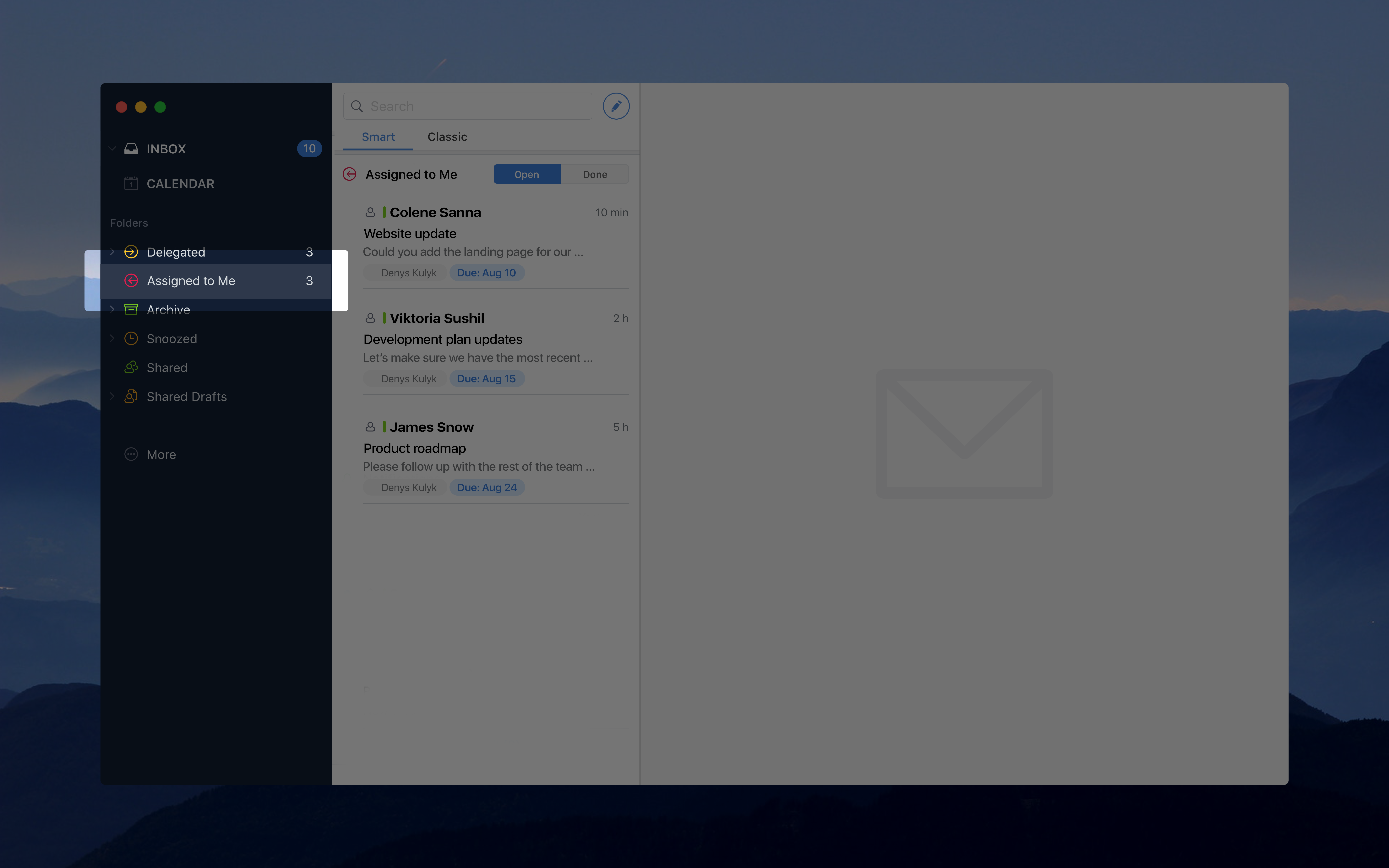
As a reminder, Spark lets you discuss email threads with your colleagues in a comment area, @-mention your colleague and add attachments and links. When you know what to say, you can create a draft, ask for feedback and collaborate like in Google Docs.
Delegation is a bit more powerful than simply sharing an email with a colleague. For instance, you can set a due date and mute the conversation. This way, you can hand-off some work and focus on something else.
Spark for Teams uses a software-as-a-service approach. It’s free for small teams and you have to pay $6.39 to $7.99 per user per month to unlock advanced features, such as unlimited email templates and unlimited delegations. Free teams are limited to 10 active delegations at any time.
Powered by WPeMatico
TwitSnap? Twitter launches new camera feature to demote text
Twitter is rolling out the redesign to its camera feature TechCrunch reported on a month ago that’s designed to let you capture photos, videos and live footage and connect them to global conversations. Starting today, when you swipe left from the Twitter timeline, you’ll get the new camera that’s no longer buried in the tweet composer. After you capture some media (no uploads for now), you can overlay a location, hashtag or some words on a colored label. But what’s really special is that Twitter will show this media in a larger, more immersive format in the feed with the imagery appearing before the text in your tweet.

Twitter isn’t launching Stories or some dedicated feed of photos to rival Instagram. But it wants to become a more real-time lens on the world rather than just an interpretation of it through people’s words. The enhanced camera could get more people shooting media, which could make Twitter more accessible to new users daunted by walls of text. More visual content also makes it easier to slip more visual ads into the feed.
See it? Tweet it! Our updated camera is just a swipe away, so you get the shot fast. Rolling out to all of you over the next few days. pic.twitter.com/moOEFO2nQq
— Twitter (@Twitter) March 13, 2019
Twitter tells me it’s not giving tweets created with the camera an algorithmic boost in the main timeline. But a spokesperson told me its combined human and technology curation team may seek to spotlight Twitter Camera tweets in the Whats Happening section about live events in the Explore tab. We’ll see if media organizations and brands try to take advantage of the new camera to stand out in the feed.
When you swipe left on the timeline, you’ll see a Snapchat-style camera shutter button that records photos with a tap and looping videos up to two minutes long if you hold. A mini-swipe over and you can record video or audio-only live broadcasts without any Periscope branding (will that app just become Twitter Live?). Twitter will then recommend hashtags based on big nearby events and other signals, or you can add your own as well as a location and text. You can choose between six colors for the TV news-style chyron overlayed on those tags that help Twitter route the content into the imagery carousels for its different What’s Happening sections.
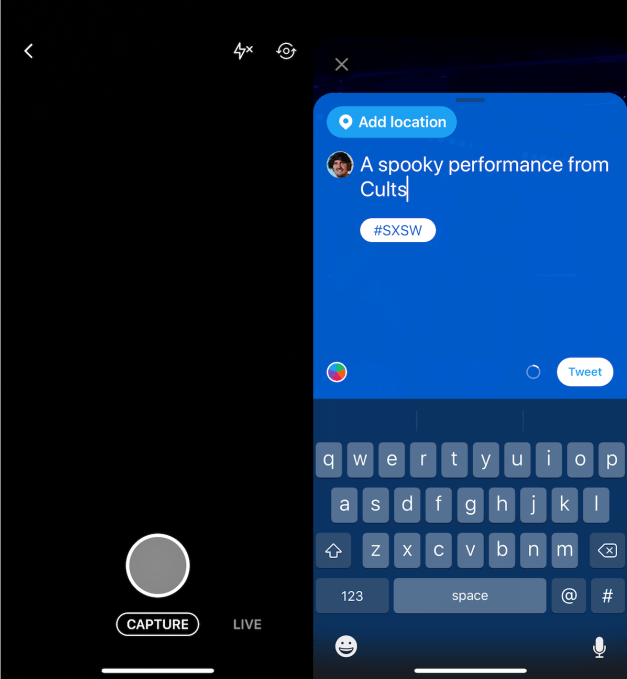
For now, there are no stickers, filters, light enhancements or other creative tools in the Twitter camera the way there is in the image uploader in the tweet composer (which conveniently also hosts a shortcut to the new camera). Twitter tells me it wants to focus on tags that will pipe content into the right conversations instead of beautifying the media. That’s a different tack than YouTube, which just started rolling out augmented reality face filters.
Historically, Twitter has been extremely slow to launch product changes for fear of disturbing its long-time loyalists. But Twitter tells me it’s turning over a new leaf and pushing the new camera out the door even with rough edges so it can start getting feedback and iterating. That’s much closer to how Facebook builds than the Twitter we’re used to. The move aligns with the recent release of Twitter’s beta prototype app twttr that launched this week. Twitter seems to finally understand that waiting to perfect each feature and being scared to experiment has left Twitter behind its rivals.
People who love Twitter can’t find the same hellscape of constant conversation anywhere else, and the new camera probably won’t change that. But shifting toward visual communication without debasing itself to chase the Stories trend could make Twitter more comfortable for a world that increasingly talks through images.
Powered by WPeMatico
Microsoft shows off Project xCloud with Forza running on an Android phone
Microsoft has shared some more information and the first look at Project xCloud. The company has been working on a cloud game streaming service for a while. Microsoft is preparing the future of gaming platforms with a device-agnostic service that lets you stream games made for the Xbox One.
And the first demo is Forza Horizon 4 running in a data center and then streamed to an Android phone attached to an Xbox One controller via Bluetooth.
“Anywhere we have a good network connection, we’ll be able to participate in Project xCloud,” Microsoft head of gaming cloud Kareem Choudhry said in the video. While Forza Horizon 4 is a demanding game and an Android phone is a tiny device, it won’t be limited to extreme scenarios like that.
Choudhry compared Project xCloud to a music streaming or video streaming service. When you have a Spotify account, you can log in from any device, such as your phone, your computer or your work laptop, and find the same music library and your personal music playlists.
You can imagine an Xbox-branded service that you could access from any device. Even if your computer has an integrated Intel GPU, you could log in and play a demanding game from that computer. Everything would run in a data center near you.
It’s easy to see how Project xCloud would work with Microsoft’s existing gaming services. The company promises the same games with no extra work for developers. You’ll access your cloud saves, your friends and everything you’re already familiar with if you’re using an Xbox or the Xbox app on your PC.
If you’ve bought an Xbox, an Xbox 360 and an Xbox One, there will be more Xbox consoles in the future. “It’s not a replacement for consoles, we’re not getting out of the console business,” Choudhry said.
Other companies have been working on cloud gaming. French startup Blade has been working on Shadow, the most promising service currently available. Shadow lets you access a Windows 10 instance running in a data center.
Microsoft wants to associate technology with content. The company already sells a subscription service. With the Xbox Game Pass, you can play Xbox One and Xbox 360 games for $10 per month. Let’s see how Project xCloud and the Xbox Game Pass work together when Microsoft starts public trials later this year.
Powered by WPeMatico
